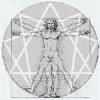“If we begin with vibrations of world 48, we can say that one note of the vibrations in this world contains an octave or SEVEN NOTES of the vibrations of the planetary world. Each note of the vibrations of the planetary world contains SEVEN NOTES of the vibrations of the world of the sun. Each vibration of the world of the sun will contain SEVEN NOTES of the vibrations of the starry world and so on. Fragments: Seven
“The first stage refers to the work of the human organism as it has been created by nature, that is to say, to the life and functions of man number one, number two, and number three. The first octave, that is, the octave of food, develops in a normal way to mi 192. At this point it automatically receives a ‘shock’ from the beginning of the second octave, and its development goes on consecutively to si 12. The second octave, that is, the air octave, begins with do 192 and develops to mi 48 where it stops. The third octave, that is, the octave of impressions, begins with do 48 and stops there. Thus SEVEN NOTES of the first octave, three notes of the second, and one note of the third octave represent a complete picture of the work of the ‘human factory’ in its first or natural stage. Nature has provided only one ‘shock,’ that is, the ‘shock’ received from the entrance of the second octave which helps mi of the first octave to pass to fa. But nature did not foresee and did not provide for the second ‘shock,’ that is, the ‘shock’ that would help the development of the third octave and thereby enable mi of the second octave to pass to fa. A man must create this ‘shock’ by his own personal efforts if he desires to increase the output of the fine hydrogens in his organism. Fragments: Nine
“Passing on to the examination of the complicated figure inside the circle we should understand the laws of its construction. The laws of unity are reflected in all phenomena. The decimal system is constructed on the basis of the same laws. Taking a unit as one note containing within itself a whole octave we must divide this unit into seven unequal parts in order to arrive at the SEVEN NOTES of this octave. But in the graphic representation the inequality of the parts is not taken into account and for the construction of the diagram there is taken first a seventh part, then two-sevenths, then three-sevenths, four-sevenths, five-sevenths, six-sevenths, and seven-sevenths. Calculating these parts in decimals we get: 1/7=0.142857 . . . 2/7=0.285714 . . . 3/7=0.428571 . . . 4/7=0.571428 . . . 5/7=0.714285 . . . 6/7=0.857142 . . . 7/7=0.999999 . . . Fragments: Fourteen

